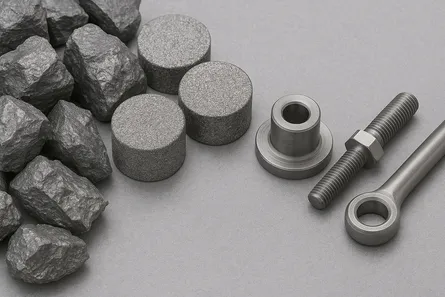
From Ore to Precision: How Titanium Parts Are Engineered for Excellence
Titanium parts used in aerospace, medical, and industrial systems don’t just start on a CNC lathe—they begin as minerals deep in the Earth. The journey from raw titanium ore to a precision-engineered component involves an intricate chain of metallurgy, chemistry, and machining expertise. This article breaks down each step in the process: from extraction and refining to alloying, forming, and final finishing. Whether it’s a jet turbine blade or a spinal implant, the excellence of titanium parts lies in the science of their transformation.Step 1: Extracting the Raw Material Titanium is primarily extracted from ilmenite (FeTiO₃) and rutile (TiO₂) ores. Mining locations: Australia, South Africa, and Canada lead in titanium ore production. Once mined, the ore undergoes chlorination to produce titanium tetrachloride (TiCl₄), a volatile compound essential for purification.Step 2: Refining via the Kroll Process The Kroll Process remains the primary method for refining titanium: TiCl₄ is reduced using magnesium (Mg) in a high-temperature reactor. The result is a porous, sponge-like raw titanium—often called titanium sponge. This sponge is melted in a vacuum arc remelting furnace to produce ingots.Though energy-intensive, the Kroll process produces high-purity titanium suitable for aerospace and medical applications.Step 3: Alloying and Ingot Formation Titanium is rarely used in pure form. It’s alloyed with elements like: Aluminum (Al) and Vanadium (V) for aerospace-grade materials (e.g., Ti-6Al-4V). Molybdenum (Mo) and Iron (Fe) for enhanced machinability and corrosion resistance.These ingots are then forged or rolled into billets, slabs, or bars depending on their intended application.Step 4: Forming and Machining Precision forming techniques shape titanium into usable formats: Hot forging and extrusion shape structural parts. CNC machining refines parts down to micron-level tolerances. EDM (Electrical Discharge Machining) is used for complex geometries.Because titanium has low thermal conductivity and high hardness, cutting requires slow speeds, rigid setups, and titanium-grade tool coatings.Step 5: Surface Finishing and Inspection Final steps involve enhancing performance and ensuring integrity: Anodizing or passivation creates a corrosion-resistant surface. Ultrasonic testing, X-ray diffraction, and dye penetrant inspection detect internal and surface defects. For medical and aerospace components, each part must pass strict ISO and ASTM standards.Applications of Precision Titanium ComponentsJet turbine blades: High strength and heat resistance Dental and orthopedic implants: Bio-compatibility and non-reactivity Chemical valves and seals: Resistance to acid and salt corrosion Motorsport parts: Weight savings without compromising strengthIndustry Outlook With advancements in 3D printing, powder metallurgy, and AI-driven quality control, the engineering of titanium parts is becoming faster, cleaner, and more precise. As manufacturing pushes for lighter, stronger, and more sustainable materials, titanium’s role will only grow.